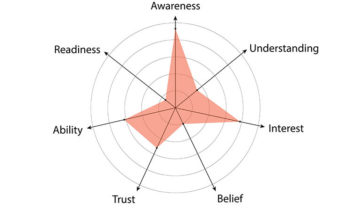Three Legs of a Stool
Communicate
Ann says both listen and learn, but also to lead when speaking with clients. Getting this balance can be tricky. There are two traditions in consulting. One is consultative selling. Ask lots of questions to understand what the client needs. For example, a client might tell an attorney, “We need to make sure we have patent protection in South America.” Further questioning, however, might uncover a need for a systematic way of tracking and complying with IP demands across the globe. The consultative seller knows to dig past a client’s pat first answers.
A second approach used by consultants is disruptive selling. Here the consultant tells a client what they are doing is wrong. The Chief Information Officer of a $500MM company asks for recommendations for a client-based ERM software. The IT consultant tells them, “I won’t give you a recommendation because I don’t believe in client-based solutions. The future is the cloud.” With disruptive selling, the consultant offers a distinctive and well-informed point of view. Says Ann, “They don’t pay me to just listen. They want advice.”
The answer, of course, is to do both — listen and learn but also lead. As F. Scott Fitzgerald famously wrote, “The test of a first-rate intelligence is the ability to hold two opposed ideas in the mind at the same time, and still retain the ability to function.” Or as Ann puts it: “Thread the needle.”
Work the Plan
Ann believes in being intentional about understanding would-be clients and current accounts. To do this she asks a set of questions:
What is the company’s strategy? This may seem obvious, but how many consultants ask a very different question: How can I get this company to buy what I am selling? By asking first about a company’s strategy, you ensure you are focused on moving the needle on what matters most to your clients.
What motivates your clients? Are they focused on making a big splash and being celebrated as a leader by their peers across their industry, or are they playing catch-up with short resources where a patch will suffice? Where are they in their career? Is this the project that will win them a big promotion or is it an afterthought that must be covered off so they can spend their time on what is really important to them? Knowing what motivates a client is a key way to unpack what success looks like for them.
Who decides? When selling services to large organizations, there is never a single decision-maker. Ann runs into three types:
- The Decider — When speaking with a company about how your services might help them, you are often talking with a key lieutenant who has been asked to research possible service providers. Your job over time is to level-up and earn the right to speak with the decision-maker.
- The Influencer — Most managers want their team to buy off on a project, especially if they are to have a hand in implementing it. The manager might be sold on your services but suggest, “Let’s set up a call with the team. I want to get their input.” While generally a good sign — they are the boss after all — it creates a strange dynamic where in order to add value to the conversation, the only thing a team member can do is point out risks or unintended consequences associated with engaging with you.
- The Vetoer — These are important stakeholders who have enough political capital in an organization that they can object to you being hired. Often, they come from left field. You are talking to a VP of Operations about auditing the energy efficiency of their manufacturing facilities and the Chief Purchasing Officer weighs in with a desire to competitively bid the project. Or you are working with a managing director of an analytics practice on sponsoring an industry summit when the CMO jumps in and says she wants to be involved because conferences come out of her budget.
Ann assures us that each of these relationships can be managed, but strongly believes in mapping and researching all the players. Individuals buy, but they exist within a buying ecosystem. Understanding and respecting this sea in which your prospects swim is critical to engaging with them and helping them achieve their goals.

Three Legs of a Stool: The Sturdy Platform Upon Which Business Development is Built
Develop Multi-Dimensional Relationships
A senior partner at a Big 4 accounting firm said to me, “My advice to young people is to make friends with whom you work at client companies. Keep track of them and build the relationships over time. These will be the people who are running companies when you are my age.” Ann echoes this advice, urging expert service providers to build multi-dimensional relationships with those with whom they work. “It is a balance between the personal and the professional.” Be interested in their lives but not over-emphasize it. “When I see them, I try and tell them something about their company they don’t know.” Ann knows the right partner is the one you trust with your work, the one with whom you have a rapport and the one that consistently over-delivers value.




